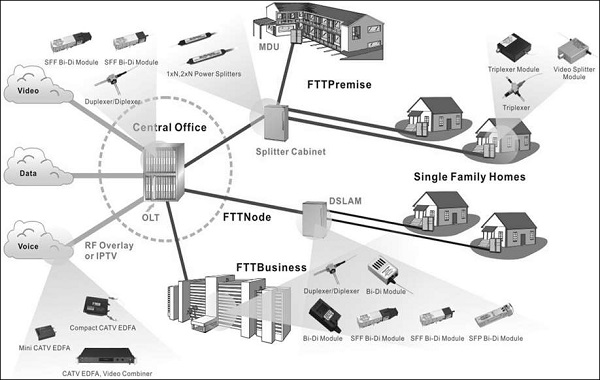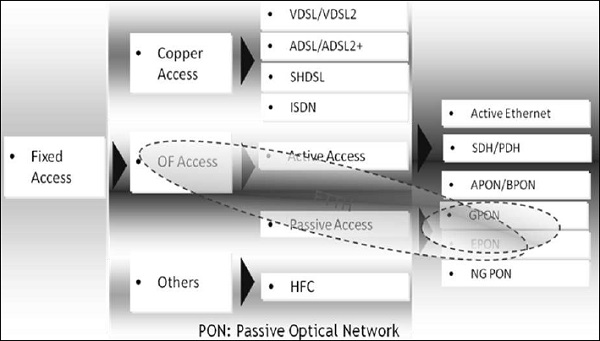
FTTH - Introduction
For the access of network technologies, there are normally two ways i.e. Fixed and the second is the Wireless way. In this tutorial, we will discuss the Fixed method, technically called as the FTTH Technology.
What is FTTH?
Fiber to the Home or simply FTTH is a technology that uses optical fiber directly from the central point to the residential premises (as shown in the following image). It provides uninterrupted high-speed internet service. Here, H includes both home and small business.

FTTH is the ultimate fiber access solution where each subscriber is connected to an optical fiber. The deployment options discussed in this tutorial are based on a complete optical fiber path from the Optical Line Termination (OLT) right to the subscriber premises.
This choice facilitates high bandwidth services and content to each customer and ensures maximum bandwidth for future demands of new services. Therefore, Hybrid options involving part fiber and part copper infrastructure networks are not included.
As an access to the home over fiber, Fiber to The Home (FTTH) scenario is mainly for the single family unit (SFU), providing a comparatively small number of ports, including the following types POTS, 10/100/1000 BASE-T, and RF (18dBmV).
Optical Fiber Method can be deployed in two ways: Active Method and Passive Method. The current mass FTTH deployment is based on the passive method. Hence, lets discuss the Passive Method in detail.
Passive Method − The two typical technologies used in this method are Ethernet Passive Optical Network (EPON) & Gigabit-capable Passive Optical Networks (GPON). Refer the following image.

Very high bit rate digital subscriber loop (VDSL) supports a maximum bit rate of 55 bps. VDSL2 has better QoS and better SNR.
ADSL (asymmetric digital subscriber line) supports a maximum bit rate of 8Mbps, however ADSL2 can go up to 12Mbps.
SHDSL stands for symmetric high bit rate digital subscriber line. The larger the diameter of the telephone, the longer the distance it could reach. The transmission rate depends on the diameter of the telephone wire.
Integrated service digital network (ISDN) is based on circuit-switched network.
Why FTTH?
Fiber offers a number of advantages over the previous technologies (Copper). The most important ones are as follows −
- Enormous information carrying capacity
- Easily upgradeable
- Easy to install
- Allows fully symmetric services
- Reduces operations and maintenance costs
- Covers very long distances
- Strong, flexible, and reliable
- Allows small diameter and lightweight cables
- Safe and secure
- Immune to electromagnetic interference (EMI)
- Lower cost
The following table lists the advanced services that can be provided through FTTH along with their bandwidth.
| Services | Bandwidth |
|---|---|
| Data Download | 10 Mbps |
| VoIP and video-conference | 1 Mbps |
| Music on demand, multimedia contents | 2 Mbps |
| On-line Gaming | 1 Mbps |
| SD Digital TV | 3 Mbps |
| HD Digital TV | 8 Mbps |
| Additional TV channels | 16 Mbps |
FTTH vs xDSL
The following table shows a typical comparison between FTTH and xDSL devices in terms of bandwidth and distance (maximum reach) −
| Transport | ADSL | ADSL2 | ADSL2+ | VDSL | VDSL2 | FTTH PON |
|---|---|---|---|---|---|---|
| Max bandwidth | D:8M | 12M | 24M | 55M | 100M | 100+ |
| U:1M | 3.5M | 1M | 19M | 100M | 100+ | |
| Distance | 3-5KM | <=1.3KM | <=100KM | |||
Distance affects the performance of xDSL profoundly.
Distance is not a problem for FTTH, as the maximum reach is more than 20 kms.
FTTH supports all the available services.
Distance and Bandwidth
The following points explain the distance and bandwidth parameters −
- ISDN − 2B + D = 2 × 64 + 16 = 144 Kbps
- HDSDN − American standard 0.51mm, 2M max 5km.
- ADSL − 3-5 km 8 Mbps
- ADSL2 − 3-5 km 12 Mbps
- ADSL2+ − 3-5 km 24 Mbps
- VDSL − ≤ 1.3 km, 55 Mbps; VDSL2 upstream/downstream 100 Mbps

FTTH Terminologies
Let us now discuss in brief about the terminologies normally associated with FTTH.
Differential Fiber Distance
An OLT is connected to several ONU/ONTs. The differential fiber distance is the difference in the distance between the nearest and the farthest ONU/ONT from the OLT. In GPON, the maximum differential fiber distance is 20 kms. This affects the size of the ranging window and it is in accordance with ITU-T G.983.1.
Logical Reach
Logical reach is defined as the maximum distance that can be covered for a particular transmission system, regardless of the optical budget. Since, Logical reach is the maximum distance between ONU/ONT and OLT except for the limitation of the physical layer - In GPON, the maximum logical reach is defined as 60 kms.
Mean Signal Transfer Delay
The mean signal transfer delay is the average of the upstream and downstream delay values between reference points. This value is determined by measuring round-trip delay and then dividing by 2. GPON must accommodate services that require a maximum mean signal transfer delay of 1.5 Ms. Specifically, GPON system must have a maximum mean signal transfer delay time of less than1.5 Ms between T-V reference points.
Optical Access Network (OAN)
The Optical Access Network is an access network towards the network side, it is also known as SNI (Service Network Interface). Up-link ports of OLT connects with L2 Switch Ring of access network. All other in-between components such as ODF/FDMS connected towards SNI comes under the Optical Access Network.
Optical Distribution Network (ODN)
In a PON Technology towards downstream side, all passive components from the PON Port of OLT to the PON Port of ONT come under Optical Distribution Network. Normally, Splitter and ODF/FDMS come under this category.
Optical Line Termination (OLT)
A Central Office (CO) equipment provides PON with the various network interfaces. One OLT serves multiple ONTs through PON Downstream transmission, i.e., from OLT to ONT is usually TDM. Upstream traffic, i.e., from ONT to OLT is usually TDMA. PON system may be either symmetrical or asymmetrical.
Optical Network Termination (ONT)/ Optical Network Unit (ONU)
An Optical Network Termination is a Customer Premises Equipment that provides user interfaces to the customer.
Physical Reach
Physical reach is defined as the maximum physical distance that can be achieved for a particular transmission system. Physical reach is the maximum physical distance between the ONU/ONT and the OLT. In GPON, two options are defined for the physical reach: 10 km and 20 km.
Service
Service is defined as a network service required by the operators. Service is described by a name that is clearly recognized by everyone, regardless of whether it is a frame structure name or a general name.
Bit Rate
GPON aims at transmission speeds greater than or equal to 1.2 Gbps. Accordingly, GPON identifies two transmission speed combinations as follows −
- 1.2 Gbps up, 2.4 Gbps down
- 2.4 Gbps up, 2.4 Gbps down
The most important bit rate is 1.2 Gbps upstream and 2.4 Gbps downstream, constituting nearly all of the deployed and planned deployment of the GPON systems.
Split Ratio
Larger the split ratio is for GPON, the more economical it is from cost perspective. However, a larger split ratio implies greater optical power and bandwidth splitting, which creates the need for an increased power budget to support the physical reach.
Split ratios of up to 1:64 are realistic for the physical layer, given current technology. However, anticipating the continued evolution of optical modules, the TC layer must consider split ratios up to 1:128.
Data Rates
| PON | DS (Mbps) | US (Mbps) |
|---|---|---|
| BPON | 155.52 | 155.52 |
| Amd 1 | 622.08 | 155.52 |
| 622.08 | 622.08 | |
| Amd 2 | 1244.16 | 155.52 |
| 1244.16 | 622.08 | |
| GPON | 1244.16 | 155.52 |
| 1244.16 | 622.08 | |
| 1244.16 | 1244.16 | |
| 2488.32 | 155.52 | |
| 2488.32 | 622.08 | |
| 2488.32 | 1244.16 | |
| 2488.32 | 2488.32 | |
| EPON | 1250 | 1250 |
| 10GEPON+ | 10312.5 | 10312.5 |